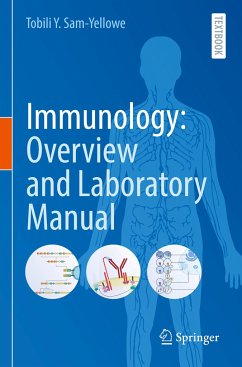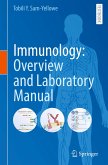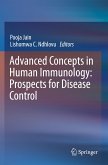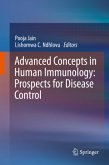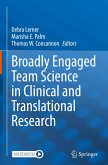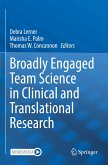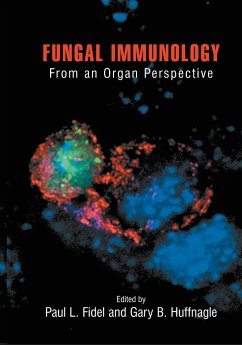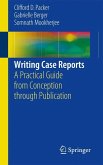Tobili Y. Sam-Yellowe
Immunology: Overview and Laboratory Manual
Tobili Y. Sam-Yellowe
Immunology: Overview and Laboratory Manual
- Broschiertes Buch
- Merkliste
- Auf die Merkliste
- Bewerten Bewerten
- Teilen
- Produkt teilen
- Produkterinnerung
- Produkterinnerung
A two-in-one text providing teaching lab students with an overview of immunology as well as a lab manual complete with current standard exercises. Section I of this book provides an overview of the immune system and immunity, and includes review questions, problem sets, case studies, inquiry-based questions, and more to provide students with a strong foundation in the field. Section II consists of twenty-two lab exercises focused on key concepts in immunology, such as antibody production, cell separation, cell function, immunoassays, Th1/Th2 cytokine detection, cell and tissue culture methods,…mehr
Andere Kunden interessierten sich auch für
![Immunology: Overview and Laboratory Manual Immunology: Overview and Laboratory Manual]() Tobili Y. Sam-YelloweImmunology: Overview and Laboratory Manual66,99 €
Tobili Y. Sam-YelloweImmunology: Overview and Laboratory Manual66,99 €![Advanced Concepts in Human Immunology: Prospects for Disease Control Advanced Concepts in Human Immunology: Prospects for Disease Control]() Advanced Concepts in Human Immunology: Prospects for Disease Control193,99 €
Advanced Concepts in Human Immunology: Prospects for Disease Control193,99 €![Advanced Concepts in Human Immunology: Prospects for Disease Control; . Advanced Concepts in Human Immunology: Prospects for Disease Control; .]() Advanced Concepts in Human Immunology: Prospects for Disease Control; .193,99 €
Advanced Concepts in Human Immunology: Prospects for Disease Control; .193,99 €![Broadly Engaged Team Science in Clinical and Translational Research Broadly Engaged Team Science in Clinical and Translational Research]() Broadly Engaged Team Science in Clinical and Translational Research58,99 €
Broadly Engaged Team Science in Clinical and Translational Research58,99 €![Broadly Engaged Team Science in Clinical and Translational Research Broadly Engaged Team Science in Clinical and Translational Research]() Broadly Engaged Team Science in Clinical and Translational Research39,99 €
Broadly Engaged Team Science in Clinical and Translational Research39,99 €![Fungal Immunology: Fungal Immunology:]() Fungal Immunology:116,99 €
Fungal Immunology:116,99 €![Writing Case Reports Writing Case Reports]() Clifford D. PackerWriting Case Reports62,99 €
Clifford D. PackerWriting Case Reports62,99 €-
-
-
A two-in-one text providing teaching lab students with an overview of immunology as well as a lab manual complete with current standard exercises.
Section I of this book provides an overview of the immune system and immunity, and includes review questions, problem sets, case studies, inquiry-based questions, and more to provide students with a strong foundation in the field. Section II consists of twenty-two lab exercises focused on key concepts in immunology, such as antibody production, cell separation, cell function, immunoassays, Th1/Th2 cytokine detection, cell and tissue culture methods, and cell and molecular biology techniques. Appendices include safety information, suggested links and readings, and standard discipline processes, protocols, and instructions.
Section I of this book provides an overview of the immune system and immunity, and includes review questions, problem sets, case studies, inquiry-based questions, and more to provide students with a strong foundation in the field. Section II consists of twenty-two lab exercises focused on key concepts in immunology, such as antibody production, cell separation, cell function, immunoassays, Th1/Th2 cytokine detection, cell and tissue culture methods, and cell and molecular biology techniques. Appendices include safety information, suggested links and readings, and standard discipline processes, protocols, and instructions.
Produktdetails
- Produktdetails
- Verlag: Springer / Springer International Publishing / Springer, Berlin
- Artikelnr. des Verlages: 978-3-030-64688-2
- 1st edition 2021
- Seitenzahl: 492
- Erscheinungstermin: 2. August 2022
- Englisch
- Abmessung: 235mm x 155mm x 27mm
- Gewicht: 739g
- ISBN-13: 9783030646882
- ISBN-10: 3030646882
- Artikelnr.: 64276762
- Herstellerkennzeichnung Die Herstellerinformationen sind derzeit nicht verfügbar.
- Verlag: Springer / Springer International Publishing / Springer, Berlin
- Artikelnr. des Verlages: 978-3-030-64688-2
- 1st edition 2021
- Seitenzahl: 492
- Erscheinungstermin: 2. August 2022
- Englisch
- Abmessung: 235mm x 155mm x 27mm
- Gewicht: 739g
- ISBN-13: 9783030646882
- ISBN-10: 3030646882
- Artikelnr.: 64276762
- Herstellerkennzeichnung Die Herstellerinformationen sind derzeit nicht verfügbar.
Tobili Sam-Yellowe is a research scientist and educator with over 30 years experience in malaria research, vaccine discovery, and research design and analysis. Dr. Sam-Yellowe is Professor of Biology at Cleveland State University.
Part I: Overview of Immunity.- Ch 1: Immunity.- Ch 2: Components of immunity.- Ch 3: Hematopoiesis.- Ch 4: The Immune system: pathogen sensing and detection.- Ch 5: Lymphoid organs.- Ch 6: Innate and Adaptive immunity.- Ch 7: Leukocyte homing, migration and recirculation.- Ch 8: Apoptosis.- Ch 9: Antigens.- Ch 10: B cell development, activation and immunoglobulin structure.- Ch 11: Immunoglobulin and T cell receptor gene rearrangements.- Ch 12: Major histocompatibility complex proteins.- Ch 13: T cell development and T cell receptor structure.- Ch 14: Cytokines.- Ch 15: Lymphocyte signals.- Ch 16: Complement fixation.- Ch 17: Cell mediated immunity.- Ch 18: Hypersensitivities.- Ch 19: Parasite Immunity.- Ch 20: Vaccines.- Ch 21: Transplantation.- Ch 22: Immune regulation and autoimmunity.- Ch 23: Immunodeficiencies.- Ch 24: Cancer.- Ch 25: Practice questions.- Ch 26: Study guide for exam. Part II. Laboratory Manual.- 27. Immunology laboratory policies.- 28. Instructions for notebook entries.- 29. Instructions for writing lab reports.- 30. Lab report topics.- 31. Exercise 1: Using a compound microscope.- 32. Exercise 2: Pipetting and dilution technique, identification of mouse lymphoid organs.- 33. Exercise 3: Blood Cell Preparation, Leukocyte differentiation and ABO Blood Typing.- 34. Exercise 4: Single Suspension of Mouse Spleen cells, Cell Viability Assays, and Identification of specific cells using surface antigens.- 35. Exercise 5: Isolation of mouse peritoneal macrophages: In vitro phagocytosis of bacterial cells.- 36. Exercise 6: Clearance of bacteria from mouse blood by the RES.- 37. Exercise 7: Hemolytic Plaque assay (The Jeme Plaque Assay).- 38. EXERCISE 8: Rabbit and Mouse Immunizations- Preparation of Polyclonal antibodies and screening assays.- 39. EXERCISE 9: Determination of Antibody Titer: Screening Techniques.- 40. EXERCISE 10: Immunodiffusion and Immunoelectrophoresis.- 41. EXERCISE 11: Protein Affinity Purification of Rabbit IgG.- 42. EXERCISE 12: Sodium Dodecyl Sulfate Polyacrylamide Gel Electrophoresis (SDS-PAGE).- 43. EXERCISE 13: Immunoblotting (Western Blotting).- 44. Exercise 14: Protein Assay.- 45. Exercise 15: Enzyme-linked Immunosorbent Assay (ELISA).- 46. EXERCISE 16: Enzyme-Linked Immunospot Assay (ELISPOT).- 47. EXERCISE 17: Immunofluorescence assay (IFA).- 48. EXERCISE 18: Flow Cytometry.- 49.EXERCISE 19: Complement Fixation Assays.- 50. Tissue Cell Culture Techniques.- 51. EXERCISE 20: Mitogen Induced Response of Lymphocytes:Detection of Band T cell Lymphocytes Using Immunofluorescence.- 52. Exercise 21: Induction of IL-2 Secretion from Mouse Lymphoma Cells.- 53. EXERCISE 22: Adoptive Transfer of Lymphocytes: Band T cell Cooperation for Antibody Production.- 54. EXERCISE 23: Macrophage Migration Inhibition.- 55. EXERCISE 24: Monoclonal Antibody Preparation.- 56. EXERCISE 25: Immunization of mice with a recombinant protein.- 57. EXERCISE 26: Polarization of T helper cells into TH1 subset.- 58. Exercise 27: Immunoprecipitation.- 59. EXERCISE 28: Induction of apoptosis in T lymphocytes and detection of apoptotic markers.- 60. EXERCISE 29: Cloning and sequencing of cDNAs of mouse variable regions of H and L chains of monoclonal antibodies.- Appendix.- Sample Practice Questions.
Part I: Overview of Immunity.- Ch 1: Immunity.- Ch 2: Components of immunity.- Ch 3: Hematopoiesis.- Ch 4: The Immune system: pathogen sensing and detection.- Ch 5: Lymphoid organs.- Ch 6: Innate and Adaptive immunity.- Ch 7: Leukocyte homing, migration and recirculation.- Ch 8: Apoptosis.- Ch 9: Antigens.- Ch 10: B cell development, activation and immunoglobulin structure.- Ch 11: Immunoglobulin and T cell receptor gene rearrangements.- Ch 12: Major histocompatibility complex proteins.- Ch 13: T cell development and T cell receptor structure.- Ch 14: Cytokines.- Ch 15: Lymphocyte signals.- Ch 16: Complement fixation.- Ch 17: Cell mediated immunity.- Ch 18: Hypersensitivities.- Ch 19: Parasite Immunity.- Ch 20: Vaccines.- Ch 21: Transplantation.- Ch 22: Immune regulation and autoimmunity.- Ch 23: Immunodeficiencies.- Ch 24: Cancer.- Ch 25: Practice questions.- Ch 26: Study guide for exam. Part II. Laboratory Manual.- 27. Immunology laboratory policies.- 28. Instructions for notebook entries.- 29. Instructions for writing lab reports.- 30. Lab report topics.- 31. Exercise 1: Using a compound microscope.- 32. Exercise 2: Pipetting and dilution technique, identification of mouse lymphoid organs.- 33. Exercise 3: Blood Cell Preparation, Leukocyte differentiation and ABO Blood Typing.- 34. Exercise 4: Single Suspension of Mouse Spleen cells, Cell Viability Assays, and Identification of specific cells using surface antigens.- 35. Exercise 5: Isolation of mouse peritoneal macrophages: In vitro phagocytosis of bacterial cells.- 36. Exercise 6: Clearance of bacteria from mouse blood by the RES.- 37. Exercise 7: Hemolytic Plaque assay (The Jeme Plaque Assay).- 38. EXERCISE 8: Rabbit and Mouse Immunizations- Preparation of Polyclonal antibodies and screening assays.- 39. EXERCISE 9: Determination of Antibody Titer: Screening Techniques.- 40. EXERCISE 10: Immunodiffusion and Immunoelectrophoresis.- 41. EXERCISE 11: Protein Affinity Purification of Rabbit IgG.- 42. EXERCISE 12: Sodium Dodecyl Sulfate Polyacrylamide Gel Electrophoresis (SDS-PAGE).- 43. EXERCISE 13: Immunoblotting (Western Blotting).- 44. Exercise 14: Protein Assay.- 45. Exercise 15: Enzyme-linked Immunosorbent Assay (ELISA).- 46. EXERCISE 16: Enzyme-Linked Immunospot Assay (ELISPOT).- 47. EXERCISE 17: Immunofluorescence assay (IFA).- 48. EXERCISE 18: Flow Cytometry.- 49.EXERCISE 19: Complement Fixation Assays.- 50. Tissue Cell Culture Techniques.- 51. EXERCISE 20: Mitogen Induced Response of Lymphocytes:Detection of Band T cell Lymphocytes Using Immunofluorescence.- 52. Exercise 21: Induction of IL-2 Secretion from Mouse Lymphoma Cells.- 53. EXERCISE 22: Adoptive Transfer of Lymphocytes: Band T cell Cooperation for Antibody Production.- 54. EXERCISE 23: Macrophage Migration Inhibition.- 55. EXERCISE 24: Monoclonal Antibody Preparation.- 56. EXERCISE 25: Immunization of mice with a recombinant protein.- 57. EXERCISE 26: Polarization of T helper cells into TH1 subset.- 58. Exercise 27: Immunoprecipitation.- 59. EXERCISE 28: Induction of apoptosis in T lymphocytes and detection of apoptotic markers.- 60. EXERCISE 29: Cloning and sequencing of cDNAs of mouse variable regions of H and L chains of monoclonal antibodies.- Appendix.- Sample Practice Questions.

